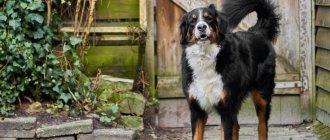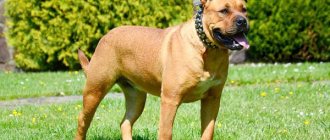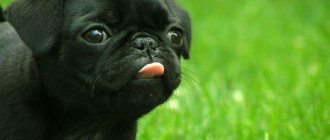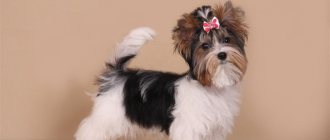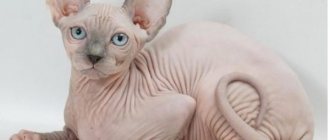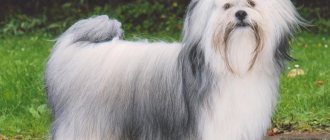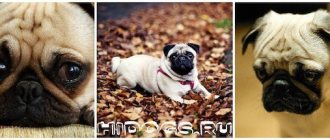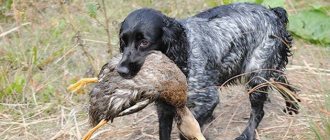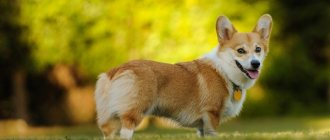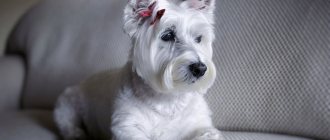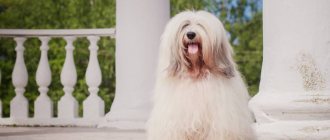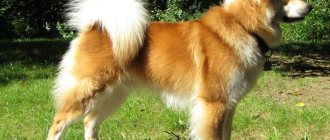The miniature schnauzer or miniature schnauzer (German: zwergschnauzer, English: miniature schnauzer) is a compact-sized service dog, which is characterized by the following qualities:
- wiry, hard wool;
- endurance and fearlessness;
- attentiveness and observation;
- confidence in your actions;
- ability to train;
- love for children;
- the presence of a guard instinct;
- good fighting qualities;
- ease of maintenance in small spaces;
- playfulness, which can turn into mischief;
- tendency to food allergies and other diseases;
- high tendency to bark and a predisposition to react loudly to all stimuli;
- significant life expectancy.
The miniature schnauzer has proven that the seriousness of an animal does not depend on size. This is the smallest representative of the group of serious schnauzers.
Characteristics of the miniature schnauzer dog breed
Males and females:
Price:
Life expectancy: from 13 to 15 years. |
Is it difficult to care for a Miniature Schnauzer? | Care is simple, but the coat requires special attention. |
Are Miniature Schnauzer and Miniature Schnauzer the same breed? | No. They differ in size. The Miniature Schnauzer is a mini copy of the Giant and Miniature Schnauzer. |
Where is it better to keep: in a city apartment or in the countryside? | The house is more comfortable, but the apartment suits him too. For city conditions, the miniature is ideal. |
Is it possible to keep an aviary? | No, he will not survive the cold winter outside. And he will be lonely in the enclosure. This is an exclusively indoor animal. |
How often should I bathe? | It is recommended to wash the decorating coat with a special product once a week. Full baths should only be given when necessary. |
How does shedding occur? | The dog does not shed on its own; it is trimmed. |
Is grooming necessary? | Yes, the fur coat is periodically combed and trimmed (to shape the eyebrows and genital area), and in spring and autumn trimming (plucking) is necessary. |
Can a haircut replace trimming? | Partial cutting of the hair does not remove dead hair. Lack of trimming leads to negative changes in the coat. This is especially true for pepper-and-salt pets. |
How long are the walks? | About 1.5–2 hours a day. |
Are there any difficulties with socialization? | There are no difficulties if the dog begins to be taken outside early - at 2.5 months (having endured quarantine after the first vaccination). |
How often do owners encounter stubbornness? | Behavior problems are discovered only with improper upbringing. The pupil always adapts to the character and desires of the owner. |
What kind of work can it do? | Used for catching rats, hunting, protection. Suitable for agility, obedience, flyball. |
Who is not suitable for a miniature schnauzer? | Sedentary people who prefer peace and quiet. |
Is it suitable for a child? | Dogs with a terrier temperament are excellent companions; they love children and allow them little pranks. |
Is it suitable for security? | This is a sensitive and brave watchman and security guard. |
Is it true that this is the most hypoallergenic breed among schnauzers? | The assertion is baseless. The dog does not shed, but the cause of allergic reactions is often associated not only with hairs, but also with other secretions. |
Do you need clothes? | In sub-zero temperatures, especially after trimming, overalls are required. |
Is keeping with other animals acceptable? | With good socialization, they are friendly towards animals of medium and large sizes, but can attack birds and small rodents. |
Advantages of the breed
- Miniatures are small dogs. This is one of the most popular breeds for the city.
- They are easily recognizable and have a striking appearance.
- They will become loyal and cheerful companions and playmates.
- They do not shed and therefore do not have an unpleasant odor.
- They are distinguished by an active life position and positivity.
- Shows all the qualities of a watchdog.
- Adapt to life in different conditions.
- Caring for them is simple, but you will have to tinker with the wool.
- They are easy to train and smart.
Flaws
- The wool has to be trimmed regularly. The procedure requires some skills. You can learn how to do it yourself, but show animals will need the services of a master.
- If mistakes are made in breeding, puppies may show excessive shyness and timidity.
- Without firm and consistent, and sometimes authoritarian, upbringing, a baby can transform into a hysterical dog with a bad character.
- The Mini Schnauzer is characterized by excessive barking.
- Submits only to those who are stronger, smarter and more cunning than him. The owner must become an authority.
- It looks like a lap dog, but is demanding exercise and needs daily walks outside.
- Has a tendency to dig holes.
- Predisposed to cancer, allergies, diabetes and eye diseases.
Maintenance and care
Miniature Schnauzer dogs are ideal for keeping in an apartment. They are no more difficult to care for than other breeds. A miniature dog cannot be at home all the time, so a stay-at-home owner will not suit him.
The pet requires long walks, trips to nature, and active physical activity.
If you plan to care for and keep them in a private home, you should know that miniature schnauzers cannot live permanently in an enclosure. In winter, it is recommended to move the dog to a warm room.
In the first days in the house, the puppy is shown the places where he should sleep, eat, and go to the toilet. The owner should take care of the convenience and comfort of the miniature dog, and should not place the dog bed in walk-through corridors, cold or noisy rooms.
The drinking bowl should always be filled with fresh and clean water.
Some owners of small dogs are litter box trained. In the case of miniature schnauzers, you should not do this. The breed is not decorative; an intelligent and proud dog will perceive the cup as permission to be permissive. Moreover, an active pet needs frequent walks, regardless of whether there is a toilet for the animal in the house or not.
Grooming
The hard hair of the miniature requires careful regular combing and periodic trimming, that is, the removal of hair that does not fall out during shedding. Grooming will keep the coat healthy and beautiful.
It is recommended to entrust the first haircut to a hairdresser, then the owner can cut the dog himself. This must be done at least once every six months, otherwise the dog will look untidy and tangles will form on its coat.
Expert opinion
Anna Abramenko
An avid dog lover. Experience in veterinary medicine since 2009.
Ask a Question
One of the characteristics of Miniature Schnauzer dogs is their haircut, which highlights their brow ridges and funny beard.
Cupping
This is not a mandatory procedure, and in some countries it is completely prohibited. But in Russia, breeders often resort to ear and tail docking, especially if it is necessary to hide the dog’s genetic deficiencies and deviations of the miniature dog from the breed standard.
The puppy is docked in the first days of life or immediately after birth.
Hygiene
In addition to caring for the dog’s fur, the owner of a miniature schnauzer needs to master other procedures:
- Bathing. There is no need to do this often, but you should always use a special shampoo - hypoallergenic and suitable for rough coats.
- Oral care. Just like a person, a dog needs to brush its teeth regularly using a brush and a special toothpaste. During the period of changing teeth, it is important to ensure that the molars do not begin to climb on top of the ones that have not fallen out. If this happens, your dog should be taken to a veterinary clinic.
- Trimming claws. For this procedure you will need wire cutters and a nail clipper.
- Cleansing eyes and ears. Schnauzer dogs are prone to otitis media and ophthalmological problems. Therefore, it is important not only to monitor the condition of their mucous membranes and the cleanliness of their hearing organs, but also to regularly clean their eyes and ears using cotton pads, swabs and special lotions.
- Preventive treatment of dogs against intestinal parasites, fleas, ticks.
If the winter in the region is harsh, it is recommended to wear clothes when walking, and overalls on rainy days.
You should not allow your miniature schnauzer to play with dangerous objects: soft things, balls, rings, plastic bottles. For such a dog, latex toys are suitable as entertainment.
Dog character, behavior
Behind the funny, almost cartoonish appearance, lies the stamina, endurance, and sometimes stubbornness that a miniature schnauzer can exhibit. The pet's character is not the simplest. But it is not difficult to direct excessive activity in the proper direction.
Miniature Schnauzers have the following traits:
- distrust of strangers and desire to protect;
- quick wit and sharp mind;
- devotion to the owner and love for the family;
- playfulness and fun;
- intransigence in games with other relatives;
- self-will and self-confidence;
- high mobility bordering on mischief;
- curiosity and desire to explore new objects along the way;
- demanding of communication, does not tolerate loneliness well;
- desire to be the center of attention.
Behavior at home
You can forget about peace if a miniature schnauzer appears in the house. The description of the breed confirms impulsiveness and energy. It is not advisable to leave a miniature dog at home alone for a long time. A bored baby will find something to do, but the owners, as a rule, don’t like them. Left alone, the dog can stage a loud concert with howling, play with shoes, and then try to check what is under the upholstery of the sofa.
The pet loves when the whole “pack” is together. He rejoices wildly when the missing family members return to the house. He is interested in children's games, ball games, and hide and seek. The reaction to strangers is the complete opposite: it is restrained and expectant. This is a service dog, albeit a very small one. The baby’s genes contain the desire to protect the home and family from the slightest attacks. They love children and listen to them with pleasure.
Behavior on the street
Socialization should be given as much attention as possible. A well-mannered dog should not bark at passers-by. He reacts calmly to strangers. This is not an innate quality, it is taught. The dog must know commands and follow them. It is advisable to undergo OKD (general training course). It is important to learn how to control your pupil's excessive barking. Miniatures can even howl to the siren of a police car or ambulance.
Difficulties also arise with calling. The Miniature Schnauzer is an enthusiastic and stubborn dog. If a mini-schnauzer is interested in something, he temporarily “loses” his hearing. It is common for a student to be obedient as long as the master’s wishes coincide with his interests. In other cases, he prefers to be guided by intuition. But these moments are corrected by education.
Attitude towards strangers, protection of the owner and home
Pets do not have the habit of running up to strangers. They show posturing only when meeting fellow tribesmen. People are treated with caution. Their approach is announced by barking. This is not a decorative lap dog, but a real fighting miniature schnauzer. The characteristics of the breed contain data on a strong guard instinct. Little ones are always on the alert.
Socialized dogs react unemotionally to strangers coming into the house and can allow themselves to be touched. But by nature they are owners. Resentment and jealousy are often shown when new residents appear in the house.
Attitude towards other animals
New animals in the house are perceived as competitors. They gradually become accustomed to such a neighborhood. If the animals grew up together, then problems usually do not arise. Cats, squirrels, and birds can be chased on the street. They do this mainly for fun; persecution rarely ends in serious attacks.
Who is not suitable for miniature?
The owners of Miniature Schnauzers are ready to talk about them forever and have difficulty remembering the disadvantages of keeping them, but the characteristic features must be taken into account when choosing a pet breed.
The miniature schnauzer is not the dog that is ready to lie on a pillow all day long and look at the world phlegmatically; this can be a problem for a stay-at-home owner. It is better to take a closer look at a breed with other characteristics if you:
- you cannot walk your dog regularly - the miniature schnauzer , despite its modest size, is not at all a pet and will not be able to go to the litter box like a cat ;
- love solitude and silence - kids have a lively disposition and will distract you and demand attention;
- you work a lot outside the home - miniature dogs do not tolerate loneliness well and need close contact with their owner;
- if you are not ready to devote time to training or are not sure that you can handle it, an ill-mannered miniature will grow up wayward, stubborn and disobedient;
- If you don't like talkative dogs, your little schnauzer will bark a lot, and you will most likely need to wean him off this.
Miniature Schnauzer care: coat, eyes, ears
The dog does not shed, does not have an unpleasant odor, eats little and can even be brushed rarely. But not everything is so idyllic. Care has a number of features. Keeping a baby will require some effort.
Eye hygiene
Puppies may experience intense discharge from the eyes. They are cleaned regularly with a damp cloth. Dried crusts in the corners of the eyes are removed daily. I carefully trim the hairs on the sides of the bridge of the nose, otherwise the hard bristles can injure the pupils.
Ear hygiene
Hanging ears require more careful care. They are less ventilated. But regardless of the shape of the ears, they are regularly cleaned of discharge. Wax is removed with an ear stick about 2 times a week.
Dental care
Teeth require special care from 2.5 to 5 months. At this age, their change takes place. If baby teeth do not fall out after the permanent ones grow in, they are removed. Otherwise the bite will be spoiled. When plaque appears, teeth are brushed. Yellowness is removed using a special tooth powder.
Nail care
Claws are inspected regularly. If a dog walks a lot on hard surfaces, it wears them down on its own. When walking on soft ground or snow, the dog does not wear down its claws. They have to be trimmed with a special nail clipper. We must also not forget about the claws on the fifth toes. They do not touch the ground and do not wear off at all.
Grooming
Representatives of the breed do not shed hair on their own; hairs have to be removed manually. The wool is plucked (trimmed) 2-3 times a year. This is a kind of replacement for seasonal molting.
The body with short hairs is combed with a fine-toothed comb. They do this daily. Once a week, attention is paid to the undercoat - combed out with a special comb, similar to a rake. The long decorative hair on the paws and face is scratched first with a sparse comb, then with a thick one.
Washing and bathing
The beard and mustache are washed with plain water after every walk and meal. Several times a week, these parts are washed with a special shampoo (diluted several times with water) and rinsed with a balm for dry hair. The balm also helps if the dog’s coat is too thick. The procedures are done every other week. Bathing with shampoo is started when necessary, usually once a season.
Character and appearance
Mini-dogs evoke the affection of others and hints of decorativeness, but strangers should be careful when handling miniature schnauzers, which exhibit an unfriendly disposition towards strangers.
Funny and miniature dogs with a playful look are capable of selfless protection in times of danger.
Representatives of the breed are serious and proud, loyal to their owner, jealous of other pets. Miniature Schnauzers get along well with children, they are playful, cheerful, active, easily adapt to different situations and are able to make independent decisions.
Walking and exercise
You can go outside with your baby for the first time 14 days after the last vaccination. This usually happens when he is 3 months old. By this time, the dog needs to be accustomed to a collar and leash. If you can walk your dog in areas where there are no other animals, you don’t have to wait until the vaccination is completed. You cannot walk pets in the city without vaccinations. After each walk, wash the paws. They do this regardless of the weather.
The miniature schnauzer puppy should go for walks as often as possible - this way he will quickly get used to fulfilling his needs outside. An adult pet is walked three times a day. Sometimes the number of walks is reduced by increasing the walking time. It is better to remove the zverg before eating. If the walk was very active, feed only 40 minutes after coming home.
Vaccinations, susceptibility to diseases
Miniatures get sick rarely. And if some kind of disease begins to manifest itself, it is not noticed immediately. This applies to both minor ailments and serious diagnoses.
Hereditary diseases are prone to:
- allergies to food and other substances;
- inflammation of hair follicles and acne formation;
- skin tumors (benign and malignant);
- eye diseases (glaucoma, retinal destruction, cataracts);
- diseases of the thyroid gland (hypothyroidism);
- diabetes mellitus;
- pancreatitis;
- pulmonary stenosis.
Only some diagnoses can be made in puppyhood. Most symptoms become noticeable in adults after two years of age. The extent of their manifestation depends on the quality of care.
Prevention of helminthiases, deworming
Foreign veterinarians do not prescribe anthelmintic drugs without first conducting a fecal examination for the presence of worms. In our conditions, deworming is carried out before vaccination, and then every 3-6 months (under the guidance of a veterinarian). He will select the drug and dosage, which is very important for small dogs.
Vaccinations, first vaccination
Puppies undergo a course of preventive vaccinations before changing teeth. Repeat the course 2-3 times (the frequency depends on the regimen). Adult animals are vaccinated once a year. The first vaccination at 1.5 months is usually carried out by the breeder. Anthelmintic drugs are given 7–14 days before vaccination. Revaccination is carried out after 3–4 weeks. Complex vaccines have proven themselves well: Nobivak, Duramun, Biocan, Vanguard. Rabies vaccinations are given separately. During vaccination, special attention to feeding is required.
Vaccination schedule with Nobivak vaccine:
- 8 weeks – Nobivak DHP+ L (preliminary deworming is required);
- 12 weeks – Nobivak DHP+ L (without deworming);
- 6–7 months (after changing teeth) – Nobivak R.
Miniature Schnauzer Health
Miniatures are very active dogs that do not like a quiet lifestyle. Because of this mobility, they fortunately do not get sick very often. But precisely because of this, there is another problem: you may not notice that your pet has a disease. This is fraught with the fact that this usually happens in the early stages, when outwardly the pet behaves as usual. And if the disease starts, it becomes more difficult to treat it.
Due to their fur, miniatures have a tendency to develop inflammation on the skin in the hair follicles, malignant or benign skin tumors. Allergies to certain components in food also occur.
Eye diseases are also not uncommon. For example, cataracts. There are even epilepsy, diabetes, heart disease and other ailments that are difficult to recognize the first time. There are diseases that manifest themselves from improper care. There are also hereditary diseases, but they are extremely rare.
The most common diseases are bacterial, viral, and parasitic.
It is important to get a correct diagnosis from a veterinarian. Further treatment depends on this
Parasites are usually a seasonal phenomenon. In summer, it is easy to become infected from parasitic insects and food. For prevention purposes, special medications can be given. Meat for your pet’s food should always be frozen or exposed to high temperatures to kill all parasites.
The owner of the pet needs to pay attention if he suddenly begins to behave differently than usual, becomes lethargic, apathetic, and inactive. If symptoms of the disease appear, you should immediately go to the veterinarian
These symptoms can be: diarrhea, excessive discharge from the eyes, vomiting, cramps, prolonged itching, baldness and much more.
To prevent many diseases, it is necessary to get vaccinated, monitor proper nutrition and care, and pay attention to all changes in the pet. With proper care, miniatures can please their owners with many years of life.
What to feed?
The feeding regimen is chosen based on age. Adult dogs are given food twice a day - evening and morning feeding. Babies are fed more often. Usually the mini schnauzer leaves the kennel at 2 months of age. The breeder supplies the new owners with food that is familiar to miniature dogs. They are gradually transferred to the new diet.
Adult dog diet
Both natural products and ready-made diets are suitable. These two types of food should not be mixed together. The simplest, but not too cheap way to ensure quality nutrition is to switch to ready-made diets. You can only buy food of at least “Premium” class.
Cheap, widely advertised feeds are produced on the basis of low-quality plant materials. There is practically no meat in them. And without meat it is impossible to raise a healthy miniature animal. Porridge and vegetables are just an addition to the main diet.
If you decide to feed your pet natural food, be patient. Fried, spicy and salty foods should not be given. Products must be raw or cooked. The food from the owners' table is no good. You should also not overfeed, as this can lead to obesity. You will quickly notice how much your Miniature Schnauzer loves to eat. The diet of puppies should be different from that of an adult dog.
Puppy diet
- 2–4 months is a period of active growth. Feed is given 4 times a day. The basis of the diet is lean meat (60–150 g), cottage cheese (40–60 g), boiled egg yolk, dairy products and vegetables. Fish is given little by little (100–200 g) up to 2 times a week, replacing meat.
- 4–6 months – the period is characterized by the change of teeth and puberty. Feed 3 times a day with high-calorie and easily digestible food.
- 6–9 months – the period of active growth continues. Feed 3 times a day. The diet remains the same. The amount of meat is increased to 180 g per day.
- 9–12 months – the dog is transferred to two feedings a day. Once a week, it is useful to arrange a half-day “hunger strike” for a teenager, eliminating one feeding.
Natural vitamin supplements for pets
In addition to a set of nutrients, you need macro- and microelements and vitamins. There are ready-made complexes for miniature schnauzers. They can be replaced with natural supplements.
- Sea kale – saturates the body with iodine and microelements. Positively affects the condition of the coat and intestinal function. Recommended for those prone to constipation.
- Flaxseed – improves the quality of the coat. Once in the intestines, it has an enveloping effect. Has anti-inflammatory properties. 1 tbsp is enough. Soak seeds in warm water overnight. Give mucus and seeds along with food. The portion is divided into two doses (morning and evening).
- Brewer's and baker's yeast - contains B vitamins, amino acids and biologically active substances. Brewer's yeast gives 1 tsp. per day during meals. Baker's yeast is boiled before use to avoid fermentation in the stomach.
- Cereal sprouts (oats, wheat) are sources of vitamins, amino acids, microelements and other essential substances. You can only germinate seeds that have not been treated with chemicals. They are fed when the sprouts reach 1 mm. Before this, the seedlings are washed.
- Sulfur is a feed additive that improves the appearance of the coat. It improves immunity and helps with poisoning. In the spring and autumn, it is recommended to give it in combination with methionine. The dosage is prescribed by the veterinarian. The course of treatment or prevention lasts a month.
Training and education
Education begins with mastering the skills of washing paws, bathing, wearing a collar and leash. You can form them even before going outside. While the baby is in quarantine, he is taught to use a leash. To do this, attach a leash and allow the miniature to move freely. Little by little they teach the baby to walk next to the owner.
Miniatures have a developed instinct to follow large objects. Use this to teach the “come” command. The leash is thrown, then the baby is called to you. After just a week of training, he will learn to distinguish his owner and will come when called. Until 4 months of age, physical exposure should be minimal. Even when the leash on the collar is tugged, they react very painfully.
Miniature schnauzers up to 6 months of age must master the basic commands: “stand”, “no”, “come to me”, “near”. This is the best time to learn. During this period, they quickly master jumping over barriers and trenches. To increase interest, you need to give in from time to time during games and activities. But the best reward for a baby is a treat.
Visiting the sports ground is useful. The formation of the necessary skills on the site occurs naturally. There the young dog gets acquainted with the tunnels and stairs. He sees the work of more experienced relatives and inherits their behavior.
If you don't train them, your Mini Schnauzer will develop bad habits. Some of them will be difficult to fix. It should be remembered that miniatures are great manipulators. They are smart and cunning. If the owner gives the pet some slack, he will certainly take advantage of it. Raising a Mini Schnauzer requires consistency, love and firmness.
What a miniature schnauzer owner should know
The miniature schnauzer vitally needs company and physical activity, otherwise he will begin to dismantle the owner’s home in search of “adventures”. Also, out of boredom, he tends to throw himself at passers-by. These dogs have a good sense of humor and an excellent mind. In addition, the Schnauzer is endowed with good reaction and ingenuity. The owner should take advantage of this.
During walks, miniatures like to involve strangers in their fun
There will be trouble with the pet if the owner is lying on the sofa, clicking through channels. Zwerg needs a partner for trips out of town, on visits, and on trips. And just walking with him is a pleasure. If a person decides to get a schnauzer, there is no need to make plans for the future. The dog will adjust the life of its owner himself, and the plans will become joint. Perhaps your outlook on life will change too.
Choosing a puppy
The Miniature Schnauzer is a popular breed. The demand for it contributed to the emergence of unscrupulous breeders. Before you go after a sweet little bundle, you need to study the standards, and under no circumstances follow impulsive desires. Both the future winner of the rings and the home companion are chosen according to their character and appearance. These are two criteria that receive maximum attention. The cost of the puppy depends on them.
Puppy exterior
It is advisable to choose a new family member together with a consultant you trust. If such a person is not nearby, read the litter inspection report. The document must contain information about which individuals were rejected and which were highly rated. And also focus on the following points:
- the puppy’s parents must be mentally balanced (get to know them if possible);
- in the litter there should not be more than half of the individuals not allowed for breeding (this is a sign of degeneration of the genus);
- the large number of puppies in the litter is alarming;
- There should be no curvature of the baby’s limbs;
- Light eyes and a short jaw are not allowed;
- preference is given to children of a square format;
- A healthy dog has a good appetite, clear eyes, and a shiny coat.
Puppy color
The breed standard stipulates the following colors: black, pepper and salt, black and silver, white with white undercoat. Black babies are not allowed white spots on their coats. This is a tribal marriage. Such individuals should not be in the litter at all. Markings of a grayish or rusty color on black miniatures are also not allowed. At the age of 3–6 months, the so-called gray hair may appear. After several plucking procedures it disappears.
White mini-schnauzers should have a well-colored nose, eyelid edges, lips, and claws. Cream stains of all shades are not allowed. The chocolate color is still considered non-standard; it is not recognized by the FCI. Black and silver individuals have silver tan and a mask. Looking at monthly babies, it is difficult to determine their future color. Pure black and black and silver babies are very similar. The color will be formed only at 2 months of age.
When choosing a miniature dog with a pepper-and-salt coat, pay attention to the contrast of the mask. The coat of the babies is dark-colored, there are no red or brown tints of guard hair. This defect is not a breeding defect, but it is difficult to correct. In the future, such a dog may be excluded from breeding. But light spots on the chest, chin and between the fingers disappear on their own over time.
Breed standards
| FCI classification | № 183/18.04.2007. Group 2, section 1 (pinschers and schnauzers). |
| Usage | Companion, for the home. |
| Appearance | A strong, stocky, wire-haired dog of small size. A smaller copy of the Standard Schnauzer. There are no signs of dwarfism. Square format (body length equals height at withers). |
| Temperament, behavior | Hardy, vigilant, smart. A pleasant companion and watchman. |
| Head |
|
| Frame |
|
| Limbs | Strong, straight and not narrowly spaced. |
| Movements | Elegant and wide. Moves freely. |
| Wool | Consists of a thick undercoat and not too close-fitting hair. Wire-like, hard and dense. |
| Color | Black with black undercoat, pepper and salt, black with silver, white. |
| Height and weight |
|
| Flaws | Deviation from the above parameters. Deformities of any kind. |
Origin story
The words “miniature” and “schnauzer” in translation mean “gnome” and “muzzle”. The breed is called young, but its roots go back to the Middle Ages. It is known that the ancestors were miniature schnauzers. There is a version that a branch was formed on the territory of modern Germany. Representatives of small schnauzers appeared in the German expanses in the 19th–20th centuries.
The brave animals were used to guard homes and catch rats. Representatives of mini-schnauzers appeared at the exhibition only in 1899. They were spotted there. And in the same year the first breed standard was developed. Schnauzers of unusually small size came to Russia in 1974, and breeding began in 1988.
